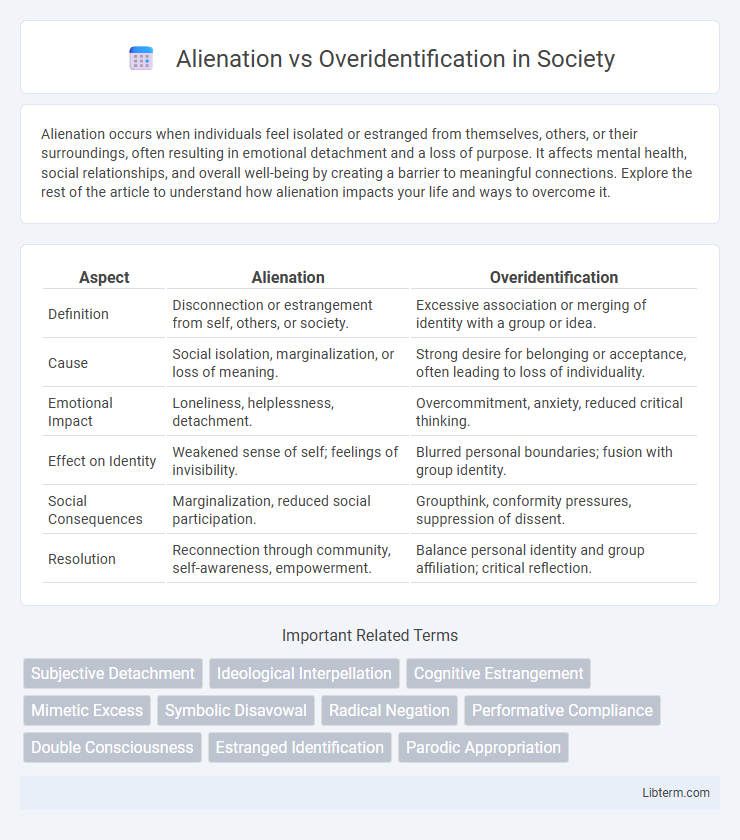Alienation occurs when individuals feel isolated or estranged from themselves, others, or their surroundings, often resulting in emotional detachment and a loss of purpose. It affects mental health, social relationships, and overall well-being by creating a barrier to meaningful connections. Explore the rest of the article to understand how alienation impacts your life and ways to overcome it.
Table of Comparison
| Aspect | Alienation | Overidentification |
|---|---|---|
| Definition | Disconnection or estrangement from self, others, or society. | Excessive association or merging of identity with a group or idea. |
| Cause | Social isolation, marginalization, or loss of meaning. | Strong desire for belonging or acceptance, often leading to loss of individuality. |
| Emotional Impact | Loneliness, helplessness, detachment. | Overcommitment, anxiety, reduced critical thinking. |
| Effect on Identity | Weakened sense of self; feelings of invisibility. | Blurred personal boundaries; fusion with group identity. |
| Social Consequences | Marginalization, reduced social participation. | Groupthink, conformity pressures, suppression of dissent. |
| Resolution | Reconnection through community, self-awareness, empowerment. | Balance personal identity and group affiliation; critical reflection. |
Understanding Alienation: Definition and Origins
Alienation refers to a psychological state where individuals feel disconnected from themselves, others, or society, often stemming from social, economic, or existential conditions. Its origins trace back to Marx's theory of labor alienation, where workers become estranged from the products of their work, leading to a loss of personal identity and meaning. Understanding alienation involves examining how modern societal structures, including capitalism and technological advancement, contribute to feelings of isolation and disenfranchisement.
Overidentification Explained: Psychological Insights
Overidentification involves an excessive emotional entanglement with a particular identity, belief, or experience, leading to a loss of objective self-awareness and increased susceptibility to bias and stress. Psychologically, it is linked to defense mechanisms where the ego amplifies specific traits or narratives to protect against feelings of vulnerability or insecurity. This phenomenon can impair emotional regulation and interpersonal relationships by reinforcing rigid cognitive patterns and limiting adaptive flexibility.
Root Causes: Why Alienation and Overidentification Occur
Alienation and overidentification stem from deep-rooted psychological and social factors such as unmet emotional needs, cultural disconnection, and identity crises. Alienation arises when individuals feel isolated or estranged from themselves or their communities, often triggered by systemic oppression or personal trauma. Overidentification occurs as a defense mechanism where one excessively aligns with certain roles or group identities to counteract feelings of insecurity or exclusion.
Social Impact: Alienation vs Overidentification
Alienation leads to social disengagement, reducing community participation and weakening social cohesion, while overidentification causes individuals to lose critical perspective, potentially fostering groupthink and reinforcing social polarization. Alienated individuals often experience isolation and decreased trust in societal institutions, whereas overidentified members may contribute to exclusionary practices and intolerance within social groups. Both phenomena disrupt healthy social dynamics by impairing dialogue and mutual understanding across diverse communities.
Alienation in Modern Society: Key Examples
Alienation in modern society is exemplified by the widespread feelings of isolation and disconnection from work, community, and self, often resulting from industrialization and digital technology advancements. Key examples include employee disengagement in corporate environments, social media-induced loneliness despite virtual connectivity, and consumer culture fostering superficial relationships. This pervasive estrangement impacts mental health, productivity, and societal cohesion, highlighting the urgent need for systemic and personal interventions.
Overidentification in Contemporary Culture
Overidentification in contemporary culture manifests as an excessive attachment to group identities, ideologies, or social roles, often leading to the suppression of individual autonomy and critical thinking. Social media platforms amplify this phenomenon by encouraging performative behaviors and echo chambers that reinforce rigid collective narratives. This dynamic contributes to polarized communities and hinders nuanced discourse in political, cultural, and social realms.
Psychological Consequences of Alienation
Alienation leads to significant psychological consequences such as feelings of isolation, loss of identity, and diminished self-worth, which can increase the risk of depression and anxiety disorders. It disrupts social connections, impairing emotional well-being and fostering a sense of helplessness or powerlessness. Prolonged alienation may cause cognitive distortions, negatively impacting motivation and overall mental health stability.
Emotional Effects of Overidentification
Overidentification with a character or situation in media can intensify emotional experiences, leading to heightened stress, anxiety, or even trauma through excessive empathy. This deep immersion often blurs boundaries between self and narrative, causing emotional exhaustion and difficulty distinguishing real-life feelings from those elicited by the media. Such intense emotional involvement may result in a loss of objectivity, impairing critical thinking and emotional regulation.
Solutions: Overcoming Alienation and Overidentification
Overcoming alienation and overidentification involves cultivating self-awareness and emotional regulation to establish a balanced sense of identity. Therapeutic approaches such as cognitive-behavioral therapy and mindfulness practices help individuals reconnect with their authentic selves and reduce distorted self-perceptions. Building supportive social networks and engaging in meaningful activities further mitigate feelings of detachment and excessive attachment to specific identities or groups.
Choosing Balance: Finding Identity without Extremes
Choosing balance between alienation and overidentification involves recognizing personal boundaries while embracing aspects of identity authentically. Alienation can lead to disconnection and loss of self, whereas overidentification risks rigid attachment and reduced adaptability. Cultivating self-awareness and flexible self-concept supports finding identity without extremes, promoting psychological well-being and social harmony.
Alienation Infographic

 libterm.com
libterm.com